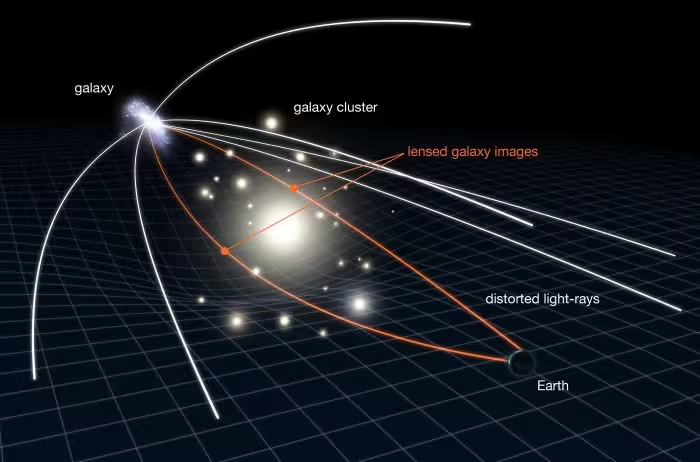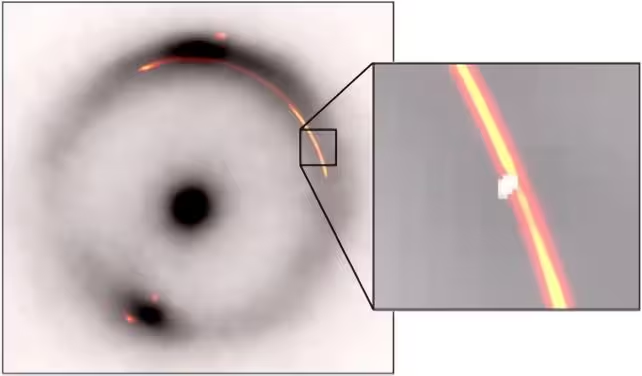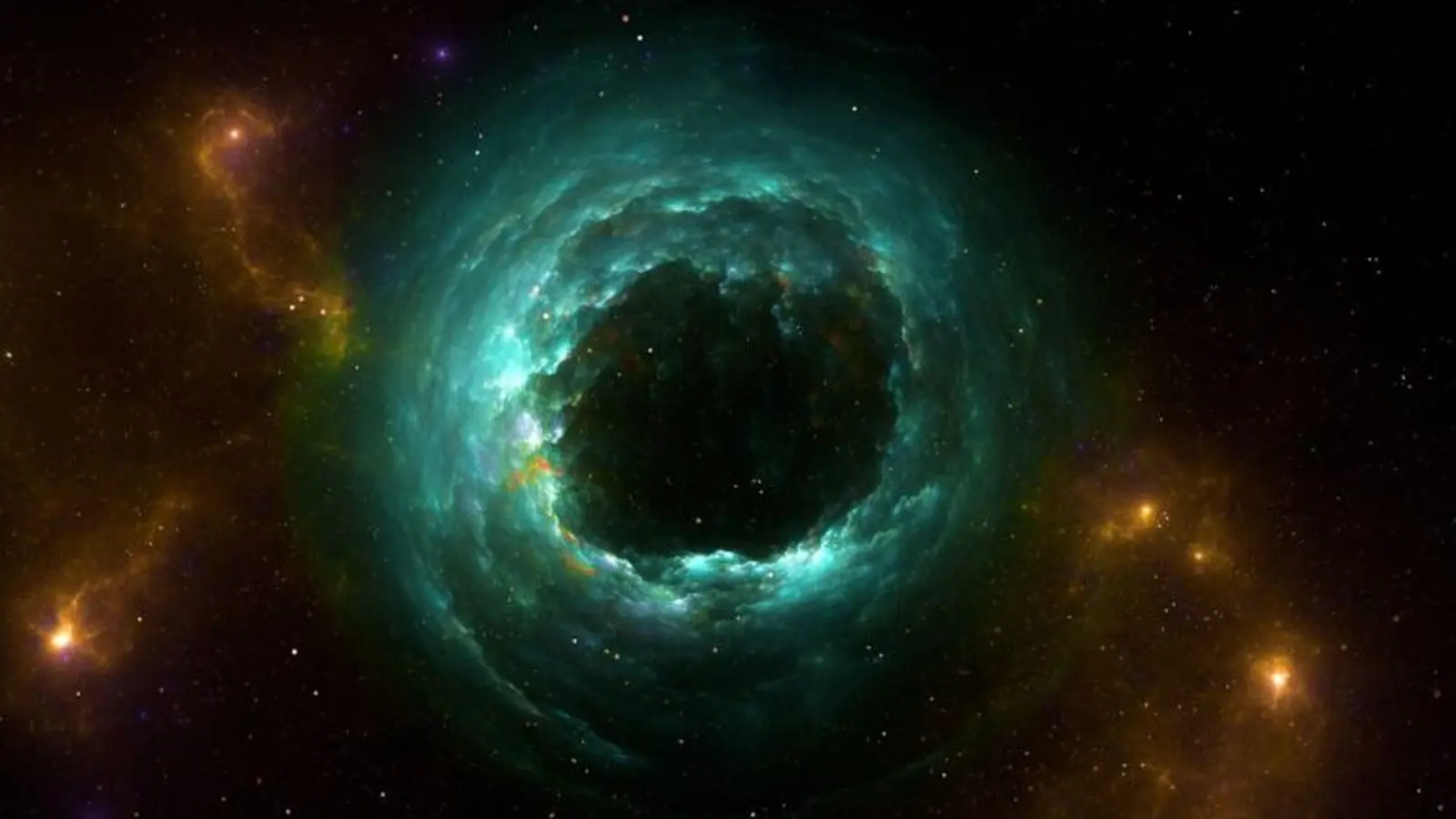6 Minutes
A compact, unseen mass roughly a million times the mass of the Sun has been detected embedded in a galaxy whose light traveled 7.3 billion years to reach Earth. Astronomers discovered this mysterious ‘‘blob’’ not by seeing it, but by mapping how it bends the light of an even more distant galaxy — a textbook example of gravitational lensing revealing the invisible.
How gravity exposed an invisible object
Dark matter is the invisible scaffolding of the Universe: it emits no light and interacts primarily through gravity. That same gravity, however, can betray its presence by distorting the light from background galaxies. When a massive foreground galaxy curves spacetime, the light from a distant source is stretched, magnified and often appears as arcs, rings or multiple images — a phenomenon called gravitational lensing.

Diagram illustrating gravitational lensing
In the lens system known as JVAS B1938+666, researchers found a subtle, localized pinch along one of the lensed arcs: a narrow dimple inconsistent with the smooth mass distribution of the main foreground galaxy. That oddity suggested a compact clump of mass — something small on cosmological scales, yet dense enough to leave a clear gravitational fingerprint.
The observation campaign: instruments and technique
Finding such a tiny gravitational imprint at cosmological distance required coordinated use of several high-precision radio telescopes. The team led by astrophysicist Devon Powell at the Max Planck Institute for Astrophysics combined data from the Green Bank Telescope, the Very Long Baseline Array (VLBA), and the European VLBI Network (EVN), supported by optical follow-up with Keck observatory data.

The JVAS B1938+666 lens system, with the inset revealing the position of the blob. The white pixels show the rough shape of the mass. (Keck/EVN/GBT/VLBA)
Using gravitational imaging techniques — methods that invert the lensed light pattern to reconstruct the mass distribution in the foreground lens — the team localized the perturbing mass with extraordinary certainty. The statistical significance of the detection is extremely high: about 26 sigma, which in practical terms means the chance this signal is a random fluctuation is vanishingly small.
What exactly could this ‘‘blob’’ be?
The object’s inferred mass is roughly one million solar masses. That’s tiny compared with typical galaxies, but enormous compared with individual stars. Crucially, it emits no detectable light in optical, radio or infrared bands, so scientists are left with two leading explanations:
- A compact clump of dark matter — a dense subhalo without stars — consistent with predictions from cold dark matter models that forecast numerous low-mass substructures around galaxies.
- An ultrafaint dwarf galaxy whose stellar population is so sparse or dim that current instruments can’t detect it directly.
Distinguishing between these options will require deeper observations and searches for more such objects. If many million-solar-mass dark clumps are found, that would reinforce cold dark matter theories; if they are rare, models may need revising.
Why this detection matters for cosmology
Detecting a million-solar-mass object by its gravitational influence at a distance of billions of light-years is a milestone. It pushes gravitational imaging into a lower-mass regime far beyond the local Universe, opening a new way to test the small-scale structure of dark matter across cosmic time.
"This is the lowest-mass object known to us, by two orders of magnitude, to be detected at a cosmological distance by its gravitational effect," Powell and colleagues note, emphasizing how the measurement demonstrates the observational feasibility of probing the million-solar-mass range in distant galaxies.
The result also feeds directly into the big picture of galaxy formation. Cold dark matter models predict a hierarchy of dark clumps — numerous low-mass subhalos embedded within larger halos. Finding or failing to find the predicted abundance of small clumps informs both particle physics and theories of structure formation.
Next steps: follow-up and surveys
Researchers plan to re-observe JVAS B1938+666 with even higher sensitivity and resolution, and to apply the same gravitational-imaging methods to other strong-lens systems. Wide, deep surveys with next-generation instruments — such as the Square Kilometre Array (SKA) in radio and the Vera C. Rubin Observatory in optical — will expand the sample of lenses and improve the odds of catching more low-mass perturbers.
If dozens or hundreds of similar clumps are cataloged, astronomers will gain statistical leverage to compare the observed abundance against theoretical predictions. That comparison could confirm standard cold dark matter or point to alternative dark matter physics that smooths structure on small scales.
Expert Insight
"Detecting a million-solar-mass dark clump so far away is like finding a pebble in a mountain range using only the ripple it makes on a distant lake," says Dr. Lena Ortiz, an astrophysicist who studies gravitational lensing. "This detection shows our imaging tools have matured. With larger lens samples we can start mapping the dark-matter landscape with real resolution, and that will sharpen constraints on what dark matter actually is."
Beyond immediate dark-matter implications, this discovery underscores the power of gravitational lensing as a natural telescope. It highlights how clever analysis of distorted light can reveal invisible structure and guide future observations that bridge cosmology and particle physics.
Source: sciencealert
Comments
Reza
26 sigma? sounds crazy. Could lens modeling or noise mimic that tiny dimple though? Not convinced yet, need independent obs and deeper IR/radio to be sure
astroset
wow this is wild, a million-sun blob found by a dimple in light… mind blown. If they find more of these, cold dark matter gets serious backup. hurry up SKA lol


Leave a Comment